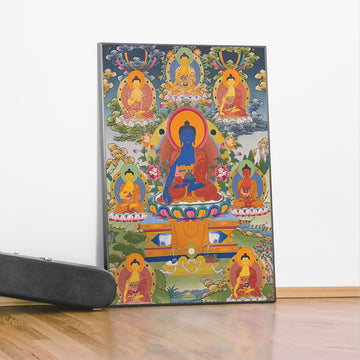The Wheel of Life, also known as the Bhavachakra or "Riduk" in Tibetan, is a powerful symbol in Buddhism that represents the cycle of life and the path to enlightenment. It is often depicted in Tibetan thangka paintings and other forms of traditional Buddhist art.
The Wheel of Life illustrates the various realms of existence, including the hell realm, the hungry ghost realm, the animal realm, the human realm, the demi-god realm, and the god realm. These realms represent different levels of suffering and happiness, with the hell realm being the most suffering and the god realm being the most blissful.
At the center of the Wheel of Life is a pig, a rooster, and a snake, which represent ignorance, desire, and hatred, respectively. These negative emotions are seen as the root causes of suffering and keep individuals trapped in the cycle of death and rebirth. In order to break free from this cycle and achieve enlightenment, it is necessary to overcome these negative emotions and actions.
The Wheel of Life also features a figure known as the "Lord of Death" at the top, who holds a noose and a wheel. The noose symbolizes the impermanence of life, while the wheel represents the cyclical nature of existence. This figure serves as a reminder that death is inevitable and that we must make the most of our time here on earth.
At the bottom of the Wheel, we see a figure known as the "Bodhisattva," who represents enlightenment and compassion. This figure offers a way out of the cycle of suffering and a path to enlightenment. By following the teachings of the Bodhisattva and working towards becoming enlightened ourselves, we can help to bring an end to the cycle of suffering for all beings.
In Buddhism, the concept of the Wheel of Life is closely connected to the concept of karma, which refers to the cause and effect of one's actions. It is believed that our actions in this life will determine our circumstances in future lives, and that by practicing virtue and compassion we can create positive karma that will lead to happier and more fulfilling lives in the future.
Overall, the Wheel of Life is an important symbol in Buddhism that teaches us about the nature of suffering and the path to enlightenment. By understanding the symbolism of the Wheel of Life and striving to overcome negative emotions and actions, we can work towards achieving enlightenment and breaking free from the cycle of death and rebirth.





